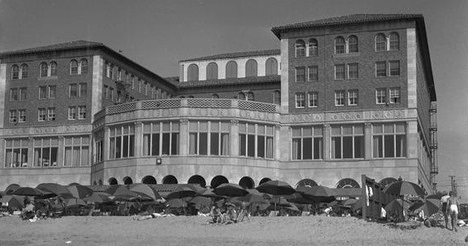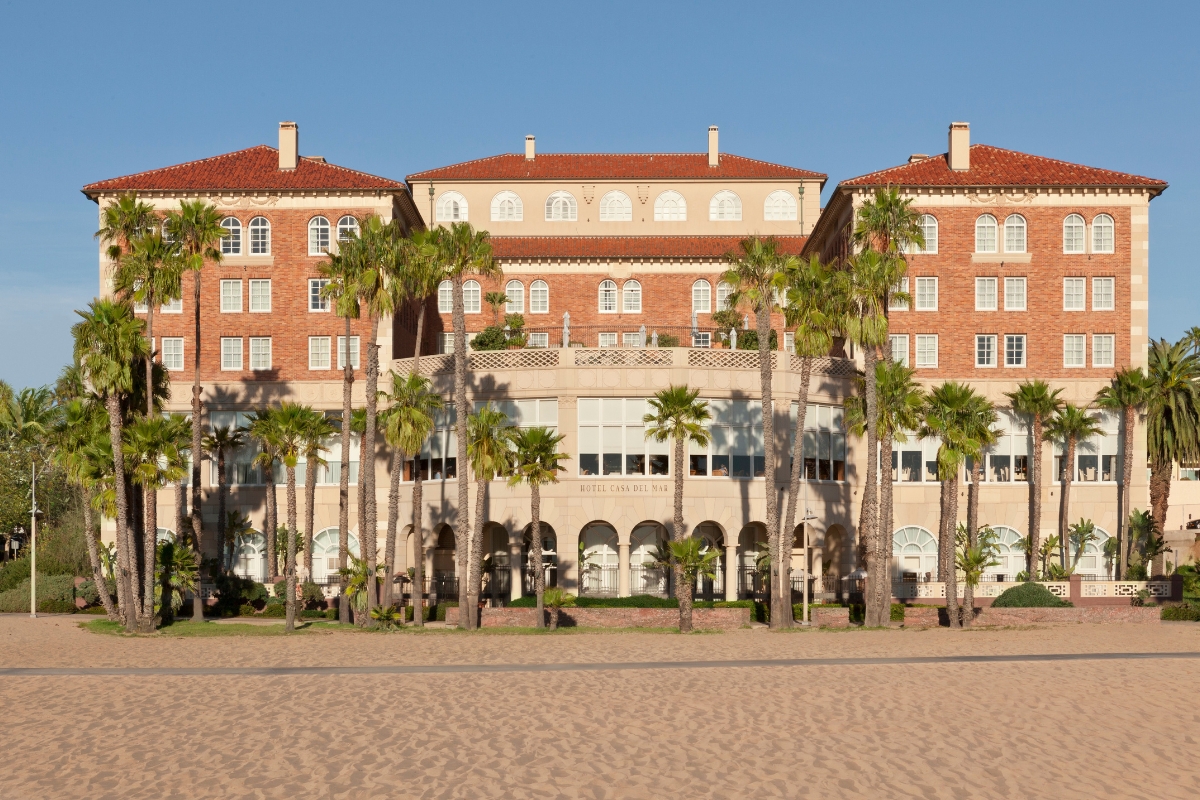Receive for Free - Discover & Explore eNewsletter monthly with advance notice of special offers, packages, and insider savings from 10% - 30% off Best Available Rates at selected hotels.
history
Discover the Hotel Casa del Mar, a luxury resort with nearly 100 years of history providing accomodations for affluent residents of the Gold Coast of California.
Hotel Casa del Mar, a member of Historic Hotels of America since 2018, dates back to 1926.
VIEW TIMELINEA member of Historic Hotels of America since 2019, the illustrious Hotel Casa del Mar is one of the few historic resorts to feature a listing on the renowned U.S. National Register of Historic Places. Its history harkens back to an era when the beaches surrounding Santa Monica were known affectionately as the “Gold Coast.” As unprecedented economic prosperity swept through the area during the 1920s, many local entrepreneurs started developing upscale beach clubs along the city’s shoreline. The clubs became an immediate overnight sensation in Southern California, offering the affluent of nearby Los Angeles a tranquil place to vacation. By the end of the decade, they had become synonymous with the city itself. Hotel Casa del Mar emerged amid this cultural transformation. Debuting in 1926 as “Club Casa del Mar,” the facility had long been the dream of two brothers from Los Angeles named Jack Harter and Tilford “Till” Harter. Both men had desired to construct a grand resort in Santa Monica that would tower in prominence above all the rest. The specifically envisioned a holiday destination that would have a core group of members at its core, who would pay annual membership fees. The brothers hoped that those “members” would involve corporate tycoons, prominent politicians, and famous entertainers. Harter and Tilford quickly hired the esteemed architect Charles F. Plummer for the task. Regarded for his work throughout the West Coast, Plummer brilliantly incorporated Mediterranean Revival-style aesthetics into the building’s impressive design. Plummer also designed an incredible layout, which he centered on a “U-shaped” plan. In all, it cost the Harters nearly $2 million to finish, which many considered to be an outrageous sum for the age. (For contrast, $2 million in 1926 would amount to more than $29 million today.)
When Club Casa del Mar finally opened, it was one of the most superlative beach resorts in the region. Charging annual dues of $10, the club offered the finest amenities and services of its day, including swimming pools, activity centers, and ballrooms. As such, people from across Southern California had become enchanted with the resort. Its popularity continued to grow to such an extent that the club maintained an average membership of 2,000 accounts during the height of its success. Several Hollywood celebrities were even regulars, like actor Clark Gable, actress Greta Garbo, and film composer Rudolf Friml. It also quickly became the center for many exciting—yet illicit—activities, such as daily gambling and drinking. For instance, Club Casa del Mar debuted as series of slot machines along its balconies, and it offered horse betting at its “Race and Sweepstakes Buffet” every Thursday. The resort also featured its own speakeasy since national Prohibition was in effect, which club members kept well-hidden from prying eyes. Yet, this period of prosperity was not destined to last forever. Following the Second World War, the Club Casa del Mar struggled to retain its antebellum popularity. Business got so dire that Till Harter came out of retirement to resurrect the its declining fortunes. But not even Harter’s knowledge and experience could save the Club Casa del Mar, and it closed in the early 1960s. After spending time as the site of various health and wellness facilities, the destination was then acquired by the Edward Thomas Hospitality Corporation. Investing some $50 million into its rehabilitation, the company completely renovated the building back into a marvelous vacation retreat. The project took several years to complete, with the structure reopening to great acclaim in 1999. Known today as “Hotel Casa del Mar,” this resplendent seaside getaway is the last remaining icon in Santa Monica from that historic golden age.
-
About the Location +
Located along the shoreline of Santa Monica, the Hotel Casa del Mar is just a few moments away from the famed Santa Monica Pier. A locally-recognized historic landmark, the Santa Monica Pier has entertained thousands of visitors since the early 20th century. It specifically debuted as the “Municipal Pier” on September 9, 1909, as part of a citywide building project to expand the Santa Monica waste management system. Even though the boardwalk offered no amenities at the time, it still managed to attract hundreds of guests due to its wonderful views of the Pacific Ocean. Sensing an opportunity, Charles I.D. Looff and his son Arthur decided to develop the area into a leading tourist destination. Purchasing a large plot of land immediately next to the Municipal Pier, they constructed their own boardwalk in 1916. Called the “Pleasure Pier,” it featured a wealth of carnival rides and games that guests could try. Its greatest attraction was the Pier Carousel, which the Looffs housed within the Looff Hippodrome. Both the merry-go-round and its attending building are currently listed together as a U.S. National Historic Landmark. Other activities involved navigating the winding corridors of a large funhouse, as well as riding on a wooden roller coaster called the “Blue Streak Racer.”
The Pleasure Pier continued to operate until 1923, when the Looff family sold their ownership stake to the Santa Monica Amusement Company. Filled with local entrepreneurs, the Santa Monica Amusement Company aspired to bring the Pleasure Pier into the national spotlight. They soon updated several of the rides, replacing the Blue Streak Racer with a faster roller coaster called “The Whirlwind.” They also installed several new facilities along the boardwalk, too, including the La Monica Ballroom. Designed by T.H. Eslick, the venue became the largest dance hall in the western United States. With its 15,000 square feet of hard maple flooring, it could easily accommodate up to 5,000 patrons. The Santa Monica Amusement Company managed to make the Pleasure Pier one of the region’s best holiday destinations by the end of the Roaring Twenties. Yet, this prosperity was not to last, as the Great Depression significantly diminished visitation to the boardwalk. Most of the carnival exhibitions permanently shut down with its material sold off piecemeal. But not all was lost for the area. Economic activity continued nonetheless, as a new breakwater began to offer space to publicly dock several dozen private boats in 1933. This new business would serve as the nucleus for the Santa Monica Yacht Club. Then, in 1938, the Works Project Administration built a new bridge and entry gate into the Municipal Pier.
At the height of World War II, Walter Newcomb purchased the Pleasure Pier. Newcomb had been managing the site for several years and had long coveted the idea of owning the boardwalk himself. His tenure as its owner saw the Pleasure Pier resume its status as the area’s most celebrated tourist attraction. As such, locals soon took to calling the area as the “Newcomb Pier.” Country musician Spade Cooley discovered the La Monica Ballroom and started broadcasting his weekly television program from its dance floor in 1948. The ballroom also hosted an exciting roller skating rink that operated as the “Skater’s Ballroom” before becoming the “Santa Monica Roller Rink.” The venue debuted the Hollywood Autocade in 1955, as well. It displayed over 100 famous cars, including Jack Benny’s “Maxwell” and the Rumpler Drop Car. Meanwhile, two brothers—George and Eugene Gordon—started operating the boardwalk’s arcade at the behest of the Newcomb family. Their management of the business made it one of the most popular places at Newcomb Pier in just a few weeks. The arcade still exists today and remains a major point of interest on the Santa Monica Pier.
The City of Santa Monica acquired the Newcomb Pier in 1974. Its city council intended to destroy the boardwalk in order to develop a manmade island that would house a private, 1500-room resort. Fortunately, local residents banded together to form the “Save Santa Monica Bay” movement, which—in part—sought to save the historic pier from demolition. The furor was so immense that the city council backed down from its plan. Nonetheless, a massive storm swept through Santa Monica in 1982 and completely devastated the area. The city quickly rallied once more around saving the Newcomb Pier and began initiating repairs as soon as the torrent subsided. After a grueling eight-year-long process, the site was back to resembling its former glory. Most of the attractions had reopened by the mid-1990s as a single entity called “Pacific Park.” By this point, the Newcomb Pier and the Municipal Pier were combined together to form the current Santa Monica Pier. The area continues to be one of Santa Monica’s most memorable historic landmarks, as well as a source of community pride for the city. Truly no trip to Santa Monica is ever complete without a visit to this wonderfully historic destination.
-
About the Architecture +
The Hotel Casa del Mar was originally designed by architect Charles F. Plummer, who used a brilliant blend of Mediterranean Revival-style architecture to create its amazing façade. Mediterranean Revival-style architecture itself is a gorgeous—but rather peculiar—structural aesthetic. Popular among American architects at the height of the Roaring Twenties, its main characteristic was its intrinsic eclecticism. While most Revivalist styles typically mimicked one or two earlier architectural forms, Mediterranean Revival-style took its inspiration from several, including Italian Renaissance, Spanish Colonial, and French Beaux-Arts. The amalgamation of so many unique design principles into one singular form was born out of a desire to create exotic buildings that closely resembled the different kinds of historic palaces scattered throughout the Mediterranean basin. As the modern hospitality industry exploded in Florida and California in the 1920s and early 1930s, American architects—as well as the hoteliers who served as their clients—hoped such an appearance would epitomize the tropical atmosphere of their respective states. But they also wished that the new style would significantly impress the throngs of tourists that had started to south and west as a means of escaping the harsh winters of the Northeast. As such, Mediterranean Revival-style architecture was predominantly used to create luxurious hotels and resorts, although some affluent Americans began using the form to construct their own personal homes. Architects August Gieger and Addison Mizner were the two most prominent professionals to popularize the style in Florida, while the likes of Bertram Goodhue and Sumner Spaulding used it frequently in California. Mediterranean Revival-style typically relied on a regular, rectangular floorplan that featured grandiose, symmetrical façades. Stucco exterior walls and red-tile roofs were perhaps the greatest structural elements. Yet, American architects also incorporated wrought iron balconies into the overall design, as well as numerous keystones and arched windows with grilles.
-
Famous Historic Guests +
Clark Gable, actor known for his roles in It Happened One Night, Mutiny on the Bounty, Gone with the Wind.
Marylin Monroe, actress known for her roles in Bus Stop and Some Like It Hot.
Greta Garbo, actress known for her roles in Grand Hotel, Romance, and Anna Christie.
Theda Bara, silent film actress regarded by contemporaries as “The Vamp” for her exotic appeal on the movie screen.
Rudolf Firml, operetta composer known for his musicals Rose-Marie, The Vagabond King, and The Three Musketeers.































